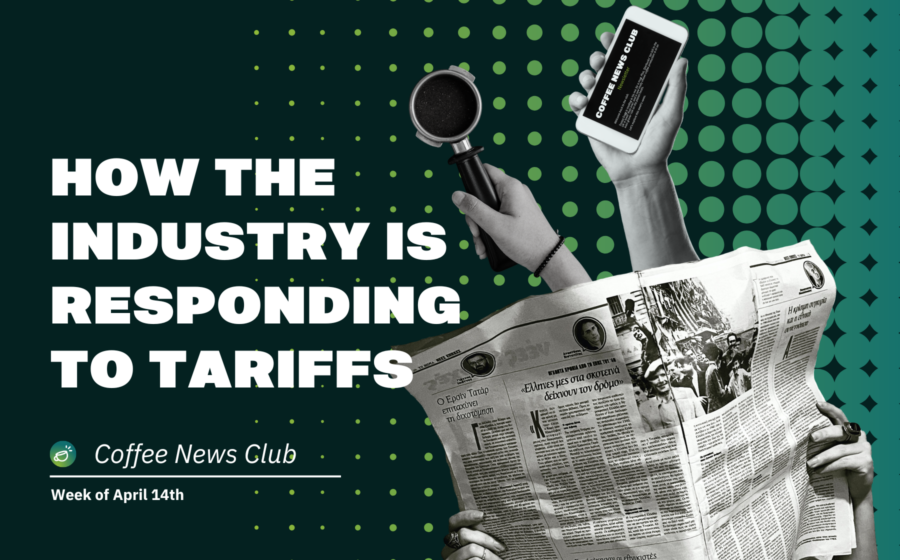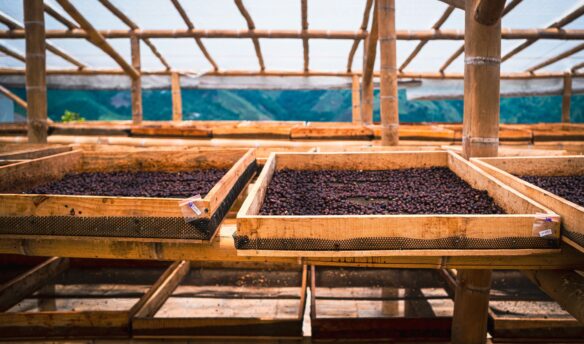Coffee prices rise in response to tariffs. Plus, how your pouring technique impacts flavor, and China’s coffee boom expands beyond the big cities.
‘The Consumer Tariff Tax is Here. Coffee Shops are Starting to Raise Prices.’ – via Business Insider
It’s been a chaotic week for the coffee industry. United States President Donald Trump announced a series of tariffs on goods from almost every coffee-producing country, only to pause their implementation (save for China) almost immediately after they were set to begin. Trump paused most of the tariffs for the next 90 days, although there’s still a 10% baseline tariff for nearly every country the United States trades with.
This week, we reported on how tariffs will impact actors across the supply chain, and while the change of course gives the industry some breathing room, the turmoil has left companies scrambling to respond. One immediate consequence is that many U.S. coffee shops are beginning to raise their prices.
Tariffs are taxes levied at the point of entry and paid by the importer (not, as Trump has claimed, by the exporting country). These increased costs are generally passed on from the importer to the buyer to, ultimately, the consumer. As Morgan McFall-Johnsen and Jordan Hart report for Business Insider, many coffee companies are raising prices to offset projected increased costs.
Even without the additional tariffs, the 10% blanket tariff is already throwing coffee companies into uncertain waters. Chris Kornman, director of education for the importer Royal Coffee, told McFall-Johnsen and Hart that the 10% tariff “erases our entire profit margin if we absorb it.”
The Crown, Royal’s coffee shop in Oakland, California, added a 50-cent increase to most of its drinks in response to the tariffs. Others have followed suit: McFall-Johnsen and Hart report that cafes across the country have either upped prices or are considering it. “Our coffee supplier needed to raise their wholesale price, and in order to make our ends meet, we need to respond by raising our coffee prices,” Illinois-based cafe The Wakery wrote on Facebook.
Another coffee company, Tasa Coffee Roasters in Chicago, increased its prices in February because of rising costs. If Trump’s full tariff plan goes into effect in 90 days, they’ll need to do so again. “It’s almost a guarantee,” co-owner Pierre Marquez said.
‘Secret to stronger pour-over coffee with no extra beans unlocked by scientists’ – via The Guardian
One of the regular beats here at the Coffee News Club is following stories about climate change. Coffee is especially susceptible to harm and quality degradation based on fluctuating weather patterns, and scientists worldwide are exploring all kinds of solutions to keep coffee production viable in the future.
Some scientists are breeding new, weather-resilient hybrid varieties; some are experimenting with hardier species that can withstand temperature and climate changes; and others are investigating ways to repurpose coffee waste.
But what if we just used less coffee? For a group of researchers at the University of Pennsylvania, their focus is on getting more out of your beans and reducing the amount of coffee you need to make a delicious pour over.
A new study published in Physics of Fluids showed that how water is poured during brewing can help extract more flavor from less coffee. The researchers isolated two critical elements: height and speed. Pouring water from a higher height encourages the coffee grounds to mix more thoroughly. Meanwhile, slowing down the pour maximizes contact time between water and grounds.
Co-author Dr. Arnold Mathijssen noted that keeping a steady flow is essential. “If you pour too slowly, or if you go too high, then the jet tends to break up into these smaller droplets, and that’s what you want to avoid as well,” Mathijssen told Nicola Davis of The Guardian.
Experimenting with the pouring technique—trying different heights and speeds—allows for increased extraction from fewer grounds. “Instead of increasing the amount of beans, the sensory profile and the strength of the beverage can be adjusted by varying the flow rate and the pour height,” the authors wrote. “In this way, the extraction efficiency could be better controlled to help alleviate the demand on coffee beans worldwide.”
‘Coffee Craze Hits China’s Smaller Cities via Budget-friendly Brews’ – via China Daily
Another thing we’ve been tracking at the Coffee News Club is the booming coffee scene in China. China’s coffee scene has grown exponentially over the last few years, largely driven by low-cost chains like Luckin and Cotti.
There were more than 132,000 coffee shops in China in 2023, with 50,000 branded or chain locations. Now, companies are increasingly looking to what China Daily calls “lower-tier markets” to expand.
Some shops are already big in smaller cities. For example, Lucky Cup, a popular chain in China with over 5,000 locations, has more than half its locations in smaller cities and towns.
“Third- and fourth-tier cities are the next ‘blue ocean’ for the coffee industry,” said Shi Jun from the Shanghai Food Association.
Along with homegrown chains, international brands are also expanding outside the big cities: Starbucks reported that it opened stores in more than 1,000 county-level markets in the first fiscal quarter of 2025 (China has 2,854 counties in its 34 provinces).
Although coffee is still widely considered a luxury, locals are beginning to develop a “coffee consciousness,” according to food industry analyst Zhu Danpeng. Social media trends also drive interest in what China Daily calls “hidden-gem cafes” in less-populated areas.
More News
‘U.S. Congressional Coffee Caucus Launches to Promote Industry’ – via Daily Coffee News
‘Bon Iver And Ruby Coffee Roasters Team Up For Limited Edition Coffees’ – via Sprudge
‘US Roaster Launches Petition to Exempt Coffee from Tariffs’ – via Global Coffee Report
‘The Coffee Futures Fund is Focused on Small Business Growth Right Now’ – via Daily Coffee News
‘Brazil Coffee Exporters Glimpse Opportunity Amidst U.S Tariffs’ – via Reuters
‘US Tariff War Brews No Jitters for Coffee Growers, Exports See YoY Surge’ – via Times of India
‘SCA Rebrands Flagship US Expo as ‘World of Coffee’ for 2026’ – via Daily Coffee News
Is Coffee Good For You?
According to a new study, cutting down on coffee could reduce the pain associated with endometriosis.
Endometriosis affects around 190 million people worldwide. It occurs when tissue similar to the lining of the uterus grows in other parts of the body. The cause is unknown, but the disease can cause severe pain and result in difficulties in conceiving.
For the study, published in the journal JAMA Network Open, researchers at the University of Edinburgh in Scotland surveyed 2,599 people—the largest international survey on diet and endometriosis ever conducted. Of those surveyed, 43% reported a reduction in pain when they cut down on coffee or caffeine, Victoria Allen writes in The Guardian. Those who cut down on alcohol, dairy, and gluten also saw pain reduction.
Although endometriosis affects millions of people around the world, there has been very little research into its causes or possible treatments. Because of this, Allen reports that it takes almost seven years on average to be diagnosed. Current treatments include surgery, which Allen describes as “only a short-term fix,” or managing symptoms through hormonal contraceptives.
“It really feels like we are on the cusp of something pretty big with understanding how diet affects endometriosis symptoms,” said lead author Professor Philippa Saunders.
Other experts noted the small sample size and self-reported nature of the data, calling the results promising but emphasizing the need for further clinical studies.
“This study provides valuable insights into the lived experiences of individuals with endometriosis who have explored dietary modifications and supplements to manage their pain,” said Dr. Nilufer Rahmioglu from the University of Oxford. “While it cannot assess causality, the findings highlight the need for further rigorous research into these potential non-hormonal strategies.”
Beyond the Headlines
‘Tech Is Changing Sourcing for Roasters With Kat Melheim of Algrano’ by Garrett Oden
‘Meet the Women Fuelling India’s Coffee Market Growth’ by Kathryn Lewis
‘How Tariffs and Private Equity Are (Loosely) Connected’ by Ashley Rodriguez
















